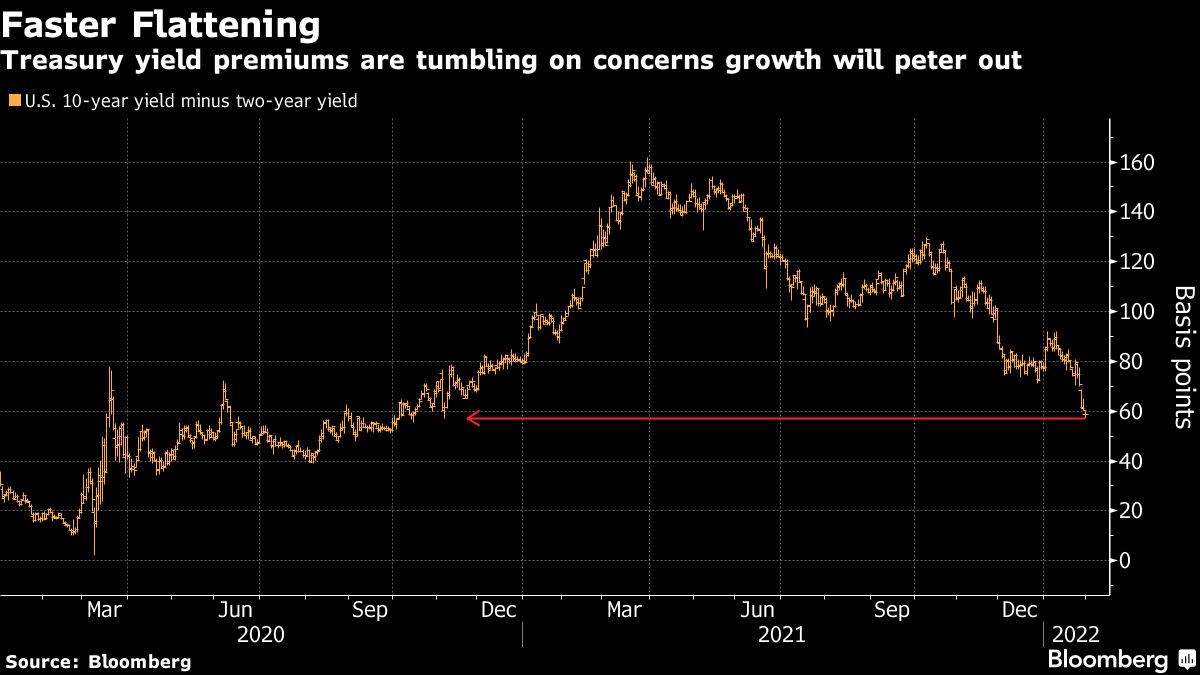
(Bloomberg) — The Treasury yield curve flattened to the lowest level in over a year on Monday as the prospect of a super-sized Federal Reserve rate increase in March gained traction, weighing disproportionately on shorter-dated tenors.
Two-year U.S. yields climbed 3 basis points to about 1.2% after Raphael Bostic, the president of the Fed’s Atlanta branch, said the U.S. central bank could raise its benchmark rate by 50 basis points if a more aggressive approach to taming inflation is needed. That narrowed the gap with the rate on the benchmark 10-year note to below 60 basis points for the first time since November 2020.
Investors are anticipating a more aggressive Fed tightening path after Chair Jerome Powell said last week that the economy is in a stronger position than the previous tightening cycle in 2015-2016 when policy makers raised rates at a gradual pace. Powell also suggested that the Fed would start reducing its nearly $9 trillion balance sheet after it raised rates.
Traders have fully priced in five quarter-point rate hikes this year, with a rising chance for a 50-basis point increase in March. But they’re less sanguine on the outlook further out. The last time the Fed delivered a half-point increase to borrowing costs was at the height of the dot-com bubble in 2000.
“Today’s price action follows Bostic’s comments on the possibility of a 50bp hike at the March meeting,” said Subadra Rajappa, head of U.S. rates strategy at Societe Generale SA. The “curve likely retains a flattening bias until we get more details on balance-sheet runoffs. This is a ‘stop and go’ economy so it will be difficult for the market to price in a higher terminal funds rate without evidence of a robust recovery.”
Investors globally are embracing more hawkish central banks to combat inflation, piling pressure on government bonds. The Bank of England is expected to raise its policy rate on Feb. 3 to 0.50%, from 0.25%. Meanwhile, traders are ramping up wagers on rate increases from the European Central Bank before its meeting the same day, challenging policy makers who have pushed back against the idea of raising borrowing costs this year.
Global government bonds have lost about 1.8% this month through Friday, following a 6.6% decline last year, according to the Bloomberg Global Aggregate Treasuries Total Return Index.
In an interview with the Financial Times, Bostic stuck to his call for three quarter-point interest rate increases in 2022, while saying that a more aggressive approach was possible if warranted by the economic data. Bostic is a non-voting member of the FOMC this year.
“In the absence of any official commentary to contrast the market’s projected path of rate hikes, we’re reluctant to fade investors’ Fed expectations at the moment,” Ian Lyngen, head of U.S. rates strategy at BMO Capital Markets, wrote in a note on Monday titled “Don’t Fade Flatter … Yet.”
Gang Hu, managing partner at Winshore Capital Partners LP in New York, said there’s a mismatch between the euro-dollar market’s pricing of the Fed’s interest rate path and inflation expectations embedded in Treasury Inflation-Protected Securities, or TIPS.
Investors are betting that the Fed will end the tightening cycle in about two years, at about 1.65%, as the difference between implied yields on euro-dollar contracts expiring in 2023 and 2024 narrowed to almost zero. In contrast, the TIPS market is pricing in an increase of about 4% in the core consumer price index this year, and a rise of more than 3% in 2023, according to Hu, who trades inflation-linked securities.
Taken together, the market is betting that inflation will stay well above the Fed’s 2% target for the next two years, but the Fed will only tighten gently, he said.
“The market is inconsistent,” said Hu. “Either the inflation forecast is too high or the Fed needs to hike more.”
©2022 Bloomberg L.P.